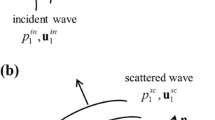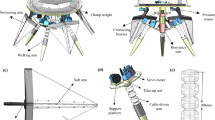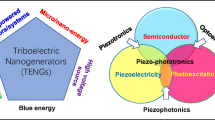Abstract
Since a first proof-of-concept for an autonomous micro-swimming device appeared in 2005 a strong interest on the subject ensued. The most common configuration consists of a cell driven by an external propeller, bio-inspired by bacteria such as E.coli. It is natural to investigate whether micro-robots powered by internal mechanisms could be competitive. We compute the translational and rotational velocity of a spheroid that produces a helical wave on its surface, as has been suggested for the rod-shaped cyanobacterium Synechococcus. This organisms swims up to ten body lengths per second without external flagella. For the mathematical analysis we employ the tangent plane approximation method, which is adequate for amplitudes, frequencies and wave lengths considered here. We also present a qualitative discussion about the efficiency of a device driven by an internal rotating structure.
Similar content being viewed by others
References
Berg, H.C., How Spirochetes May Swim, J. Theoret. Biol., 1976, vol. 56, no. 2, pp. 269–273.
Blake, J. R., A Spherical Envelope Approach to Ciliary Propulsion, J. Fluid Mech., 1971, vol. 46, pp. 199–208.
Blake, J. R., Infinite Models for Ciliary Propulsion, J. Fluid Mech., 1971, vol. 49, pp. 209–222.
Brahamsha, B., Non-Flagellar Swimming in Marine Synechococcus, J. Mol. Microbiol. Biotechnol., 1999, vol. 1, pp. 59–62.
Brennen, C., An Oscillating-Boundary-Layer Theory for Ciliary Propulsion, J. Fluid Mech., 1974, vol. 65, pp. 799–824.
http://web.mit.edu/1.63/www/Lec-notes/Surfacetension/Lecture2.pdf
Chan, B., Balmforth, N., and Hosoi, A., Building a Better Snail: Lubrication and Adhesive Locomotion, Phys. Fluids, 2005, 113101.
Childress, S., Mechanics of Swimming and Flying, Cambridge: Cambridge Univ. Press, 1978.
Childress, S., Inertial Swimming as a Singular Perturbation, in ASME 2008 Dynamic Systems and Control Conference, Paper DSCC2008-2294, 1413–1420 (2008).
Childress, S., Spagnolie, S., and Tokieda, T., A Bug on a Raft: Recoil Locomotion in a Viscous Fluid, J. Fluid Mech., 2011, vol. 669, pp. 527–556.
Chwang, A.T., Winet, H., and Wu, T.Y., A Theoretical Mechanism of Spirochete Locomotion, J. Mechanochem. Cell Motil., 1974, vol. 3, no. 1, pp. 69–76.
Cortez, R., The Method of Regularized Stokeslets, SIAM J. Sci. Comput., 2001, vol. 23, no. 4, pp. 1204–1225.
Cortez, R., Fauci, L., and Medovikov, A., The Method of Regularized Stokeslets in Three Dimensions: Analysis, Validation and Application to Helical Swimming, Phys. Fluids, 2005, vol. 17, pp.1–14.
Cortez, R., Fauci, L., and Cowen, N., Simulation of Swimming Organisms: Coupling Internal Mechanics with External Fluid Dynamics, Computing in Science & Engineering (IEEE/AIP), May–June 2004, pp. 38–45.
Dreyfus, R., Baudry, J., Roper, M., Fermigier, M., Stone, H., and Bibette, J., Microscopic Artificial Swimmers, Nature, 2005, vol. 437, pp. 862–865.
Ebbens, S. and Howse, J., In Pursuit of Propulsion at the Nanoscale, Soft Matter, 2010, vol. 6, pp. 726–738.
Ehlers, K.M., Samuel, A.D., Berg, H.C., and Montgomery, R., Do Cyanobacteria Swim Using Traveling Surface Waves?, Proc. Natl. Acad. Sci. USA, 1996, vol. 93, no. 16, pp. 8340–8343.
Ehlers, K. and Koiller, J., Could Cell Membranes Produce Acoustic Streaming? Making the Case for Synechococcus Self-Propulsion, Mathl. Computer Modelling, 2011, vol. 53, nos. 7–8, pp. 1489–1504.
Ehlers, K. and Oster, G., The Mysterious Swimming of Synechococcus, PLoS Comp. Biol., submitted.
Fair, M.C. and Anderson, J.L. Electrophoresis of Nonuniformly Charged Ellipsoidal Particles, J. Colloid Interface Sci., 1989, vol. 127, no. 2, pp. 388–400.
Faraday, M., On a Peculiar Class of Acoustical Figures; and on Certain Forms Assumed by Groups of Particles Upon Vibrating Elastic Surfaces, Philos. Trans. R. Soc. Lond., 1831, vol. 121, pp. 299–340.
Happel, J. and Brenner, H., Low Reynolds Number Hydrodynamics: With Special Applications to Particulate Media, New York: Springer, 1983.
Jahn, T. L. and Landman, M.D., Locomotion of Spirochetes, Trans. Amer. Microscopical Soc., 1965, vol. 84, no. 3, pp. 95–406.
Jung, S., Mareck, K., Fauci, L., and Shelley, M. J., Rotational Dynamics of a Superhelix Towed in a Stokes Fluid, Phys. Fluids, 2007, vol. 19, 103105.
Kanso, E., Swimming in an Inviscid Fluid, Theoret. Comput. Fluid Dynamics, 2010, vol. 24, nos. 1–4, pp. 201–207.
Koiller, J., Ehlers, K., and Montgomery, R., Problems and Progress in Microswimming, J. Nonlinear Science, 1996, vol. 6, no. 6, pp. 507–541.
Koiller, J., Ehlers, K., and Chalub, F., Acoustic Streaming: The Small Invention of Cyanobacteria? Arbor/CSIC, 2010, vol. 746, pp. 1089–1115.
Kozlov, V.V. and Ramodanov, S. M., On the Motion of a Body with a Rigid Shell and Variable Mass Geometry in a Perfect Fluid, Dokl. Ross. Akad. Nauk, 2002, vol. 382, no. 4, pp. 478–481 [Dokl. Phys., 2002, vol. 47, no. 2, pp. 132–135].
Kulić, I.M., Thaokar, R., and Schiessel, H., Twirling DNA Rings — Swimming Nanomotors Ready for a Kickstart, Europhys. Lett., 2005, vol. 72, no. 4, pp. 527–533.
Lac, E., Barthés-Biesel, D., Pelekasis, N.A., and Tsamopoulos, J., Spherical Capsules in Three-Dimensional Unbounded Stokes Flows: Effect of the Membrane Constitutive Law and Onset of Buckling, J. Fluid Mech., 2004, vol. 516, pp. 303–334.
Lighthill, J., On the Squirming Motion of Nearly Spherical Deformable Bodies through Liquids at Very Small Reynolds Numbers, Comm. Pure Appl. Math., 1952, vol. 5, pp. 109–118.
Lighthill, J., Acoustic Streaming, J. Sound Vibration, 1978, vol. 61, no. 3, pp. 391–418.
Lighthill, J., Helical Distributions of Stokeslets, J. Engrg. Math., 1996, vol. 30, pp. 35–78.
Ludwig, W., Zur Theorie der Flimmerbewegung (Dynamik, Nutzeffekt, Energiebilanz), Z. Vergl. Physiol., 1930, vol. 13, pp. 397–504.
McCarren, J., Microscopic, Genetic, and Biochemical Characterization of Non-Flagellar Swimming Motility in Marine Cyanobacteria, Ph.D. Thesis, Scripps Institution of Oceanography, Univ. of California, San Diego, 2005 (download from http://openwetware.orgwikiJay McCarren)
Miloh, T., Galper, A., Self-Propulsion of General Deformable Shapes in a Perfect Fluid, Proc. R. Soc. Lond. Ser. A Math. Phys. Eng. Sci., 1993, vol. 442, pp. 273–299.
Nan, B., Chen, J., Neu, J.C., Berry, R.M., Oster, G., and Zusman, D.R., Myxobacteria Gliding Motility Requires Cytoskeleton Rotation Powered by Proton Motive Force, www.pnas.org/cgi/doi/10.1073/pnas.1018556108 (early edition, 2011).
Nyborg, W., Acoustic Streaming due to Attenuated PlaneWaves, J. Acoust. Soc. America, 1953, vol. 25, no. 1, pp. 68–75.
Purcell, E. M., Life at Low Reynolds Number, Amer. J. Phys., 1977, vol. 45, no. 1, pp. 3–10.
Purcell, E.M., The Efficiency of Propulsion by a Rotating Flagellum, Proc. Natl. Acad. Sci. USA, 1997, vol. 94, pp. 11307–11311.
Nelson, B. J., Kaliakatsos, I.K., and Abbott, J. J., Microrobots for Minimally Invasive Medicine, Annu. Rev. Biomed. Eng., 2010, vol. 12, pp.55–85.
Shapere, A. and Wilczek, F., Self Propulsion at Low Reynolds Numbers, Phys. Rev. Lett., 1987, vol. 58:20, pp. 2051–2054.
Shapere, A. and Wilczek, F., Geometry of Self-Propulsion at Low Reynolds Number, J. Fluid Mech., 1989, vol. 198, pp. 557–585.
Shapere, A., A Theory of Something, Ph.D. Thesis, Princeton University, 1989.
Sitti, M., Miniature Devices: Voyage of the Microrobots, Nature, 2009, vol. 458, pp. 1121–1122.
Stone, H.A. and Samuel, A.D.T., Propulsion of Microorganisms by Surface Distortions, Phys. Rev. Lett., 1990, vol. 77, pp. 4102–4104.
Taylor, G. I., Analysis of the Swimming Microscopic Organisms, Proc. R. Soc. Lond. Ser. A Math. Phys. Eng. Sci., 1951, vol. 209, pp. 447–461.
Taylor, G. I., The Action of Waving Cylindrical Tails in Propelling Microscopic Organisms, Proc. R. Soc. Lond. Ser. A Math. Phys. Eng. Sci., 1952, vol. 211, pp. 225–239.
Tortora, G., Valdastri, P., Ekawahyu Susilo, E., Menciassi, A., Dario, P., Rieber, F., and Schurr, M., Propeller-Based Wireless Device for Active Capsular Endoscopy in the Gastric District, Minimally Invasive Therapy & Allied Technologies, 2009, vol. 18, no. 5, pp. 280–290.
Takayama, T. and Hirose, S., Amphibious 3D Active Cord Mechanism “HELIX” with Helical Swimming Motion, IEEE/RSJ International Conference on Intelligent Robots and Systems (2002).
Yu, T. S., Lauga, E., and Hosoi, A. E., Experimental Investigations of Elastic Tail Propulsion at Low Reynolds Number, Phys. Fluids, 2006, vol. 18, 091701.
Wang, C.-Y. and Jahn, T. L., A Theory for the Locomotion of Spirochetes, J. Theoret. Biol., 1972, vol. 36, no. 1, pp. 53–60.
Waterbury, J. B., Wiley, J. M., Franks, D. G., Valois, F. W., and Watson, S.W., A Cyanobacterium Capable of Swimming Motility, Science, 1985, vol. 230, no. 4721, pp. 74–76.
Williams, W.E., Boundary Effects in Stokes Flows, J. Fluid Mech., 1966, vol. 24, no. 2, pp. 285–291.
Wolgemuth, C. W., Charon, N. W., and Goldstein, S. F., The Flagellar Cytoskeleton of the Spirochetes, J. Mol. Microbiol. Biotechnol., 2006, vol. 11, pp. 221–227.
Wu, T.Y., Swimming of a Waving Plate, J. Fluid Mech., 1961, vol. 10, pp. 321–344.
Author information
Authors and Affiliations
Corresponding author
Rights and permissions
About this article
Cite this article
Ehlers, K.M., Koiller, J. Micro-swimming without flagella: Propulsion by internal structures. Regul. Chaot. Dyn. 16, 623–652 (2011). https://doi.org/10.1134/S1560354711060050
Received:
Accepted:
Published:
Issue Date:
DOI: https://doi.org/10.1134/S1560354711060050




